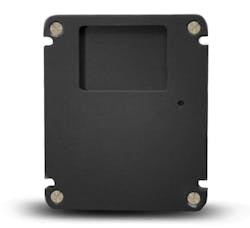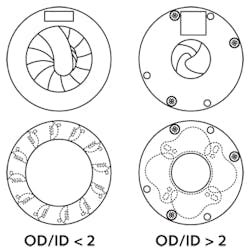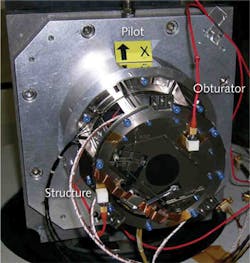STEPHEN PASQUARELLA
Electromechanical shutters are vital components in a broad spectrum of optical assemblies and systems. Shutter requirements are sometimes not apparent or considered during optical system design; other times, they need to be expanded upon after the launch of a system. Additionally, requirements may be added by the ultimate end user of a system that necessitate the implementation of a shutter into the design.
The perceived simple nature of a shutter (a device that opens and closes to gate light) leads to a tendency for its consideration to be left until later in the design cycle, or when a prerequisite of the design reveals a specified need. Such scenarios can potentially raise havoc with a product's development cycle, especially if the nature of the design requires significant time to accomplish lifetime qualification, prove new material interactions, and/or develop special test equipment for the customer's ongoing production qualification. For example, doing a lifetime-qualification test of a larger-aperture device such as a 65 mm shutter at a test rate of slightly greater than 1 Hz and a specified lifetime of 2.2 million operations can take more than 25 days to complete even for around-the-clock testing.
This article discusses a few cases where the system integrators/designers did not consider the need for a shutter device during the design pre-stages, resulting in project delays, costs adjustments, and additional testing. However, understanding certain criteria and asking a number of questions of the shutter-design team can help the design engineer to predict the need for a shutter early on and to allow for more consistent development and implementation.
A shutter is now required
In the first example case, additional specifications arising from a belatedly stated requirement for a shutter in an optical system were not known until the design of the product entered the prototype stage. A system designer's largest end user was looking for a portable camera application; once the system and optical design had been completed, the end user revealed the need for a shutter for black-reference calibration. This design requirement created a delay in the system-completion schedule.
Now a shutter had to be developed whose physical location in the optical system needed to fit within an already tight envelope. The design specifications were unique and therefore did not allow for an off-the-shelf shutter design, but rather called for a more custom shutter device, thus requiring a significant amount of time for design, testing, and implementation of a shutter into the camera. This particular scenario could have led to a seamless implementation if the designer had been provided the specification for a black reference nearer to the start of the design process.
In another case, a camera system designer was responsible for developing a lower cost, high-speed digital camera application. During the final stages of product completion, the designer came to the realization that the application required a shutter for a remote and automatic black reference. The necessary shutter would have to "fit" the existing envelope previously approved and developed for the design, and would have to use the existing voltage levels already designed into the camera. This required a specialized design in which a single large-mass blade had to move through a rectangular aperture within a very thin space envelope, similar to the shutter shown in Figure 1.
Multiple design iterations were required to find solutions to specifications that were not known at the onset of this project. For example, a specialized magnetic locking system was developed to prevent high g forces from causing the shutter to close. This had to be accomplished in a secondary design iteration, as the high g specification was not known at the inception of the project. The final design is rated to remain open during shock loads of up to 40 g.
Understanding when a shutter is necessary
At times, there is no way of anticipating whether or not a shutter may be required at the onset of a design; therefore, it is helpful to identify some important criteria up front that often lead to implementation of a shutter. Some fundamental applications that will commonly require an electromechanical shutter are for:
- Nonuniformity correction (NUC) or black-reference calibration
- Preventing smearing: here, a shutter is used to prevent this effect when the imager does not have an electronic shutter, and the camera moves relative to the acquisition of the image.
- Exposure control
- Light-source selection: here, a shutter is used when an application contains a number of fiber-optic or other light sources or sources. The shutter is used to select one of the sources.
- Protection of a sensor from foreign objects, dust, dirt, etc.
- Accurate and repeatable discrete exposures from a continuous light source or continuous-wave laser
- Control of a laser or select pulses from a laser
- Laser-safety applications: in this case, a shutter is used to provide a fast turn-off of a laser when an interlock mechanism is triggered.
- Switching an x-ray source to regulate output via exposure control
Once the system designer has anticipated the need for a shutter, there are a number of recommended questions to use as a guideline prior to the initial design (for a complete list of questions to consider, see www.uniblitz.com/custom-work-sheet). Here is a small selection of suggested questions:
1. What are the operating wavelength, surface flatness, coating type, substrate material, and power-level considerations? This information can have an effect on the actuator type due to mass considerations, manufacturability of the substrate material, and cost.
2. What is the ratio of the aperture opening to the overall size of the device (see typical aperture-to-overall-size comparison in Fig. 2)? Usually a ratio of <2 can necessitate a greater number of blades, design considerations that could decrease the reliability of a design, increased actuator complexity, decreased actuator size that can limit exposure speed, and so on.3. What are your shutter envelope considerations, and how much room is available to establish the overall size of the shutter design?
4. What are your environmental specifications?
5. Shock and vibration specifications?
6. Acoustical noise considerations?
7. Material considerations?
8. Exposure speed and frequency of operation requirements?
9. What are the safety considerations, for example, as in a laser safety application or effects of a shutter failure on the overall system?
10. Are there magnetic fields?Reliability, lifetime testing, repeatability, overall quality, performance, driver requirements, driver design, and power availability are additional criteria that need to be taken into consideration when designing a shutter system. Understanding and testing each of these criteria is time consuming, yet extremely necessary in order to qualify an electromechanical shutter design—thus exemplifying the time requirements necessary for producing a shutter, as well as the impact it can have on a product-development timeline.
Early shutter identification: PICARD satellite
When a customer learns early on in the development of an application that a shutter device is needed, a thorough vetting of the specifications can eliminate the need for redesign and other considerable delays when having to qualify a shutter design. In such scenarios, the application design will often be completed successfully within the time constraints and the planned budget.
In another example situation, a shutter was required for use in a camera/telescope design to be flown in a satellite. The primary task for this device was to achieve exposure control for the Solar Diameter Imager and Surface Mapper (SODISM) instrument aboard the PICARD satellite (see http://smsc.cnes.fr/PICARD/), to be operated by the Centre National D'études Spatiales (CNES; Paris, France).
At the onset, the satellite's system designers were able to communicate most aspects of the shutter-design requirements to the team at Vincent Associates. It was determined from these specifications and subsequent discussions that the aperture could accommodate a 35 mm shutter, pointing toward a base design starting with the Uniblitz VS35 device (see Fig. 3).This off-the-shelf shutter would then need to be modified for use in space as outlined in the specifications. All aspects of the shutter specs were considered, and included lifetime, environmental, shock, vibration, outgassing, weight, drive requirements, overall dimensions, blade coating, and so on. (The outgassing specification required a special actuator coil component. However, due to the nature of the environment, this aspect of the design was realized early on in the design process.) Our design team was able to provide a device capable of operating in a harsh environment that had no prospect of repair if a specification fell out or a complete failure were to occur.
The electronic shutter became spaceborne on June 2010 and began taking images of the sun. These images enable the detailed display of features such as sunspots (see Fig. 4). Since the launch of the PICARD mission (June 15, 2010), the SODISM instrument has acquired more than 1,300,000 images, in agreement with the capability of the shutter.All three cases discussed in this article achieved success, regardless of whether the need for a shutter was detected early on or was considered a late addition. However, as a rule, by getting answers to a number of specific questions and having a full understanding of the applications, system integrators can detect the need for a shutter as early as possible, resulting in significant savings of time and money during the development process and enabling products to get to market without delays associated with redesign and/or requalification.
Stephen Pasquarella is president of Vincent Associates, Rochester, NY; email: [email protected]; www.uniblitz.com.



